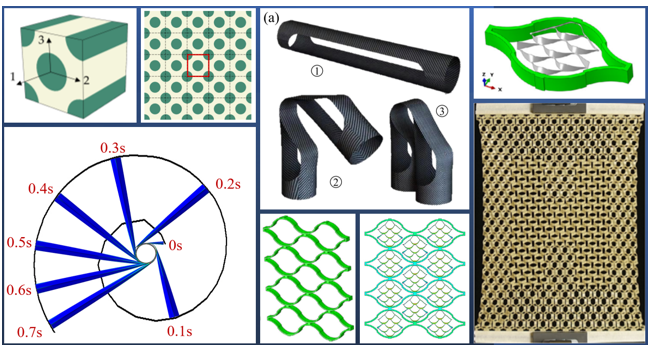Video Article Open Access
Modelling and Analysis of Composite Deployable Structures for Space Applications
Ning An1,2,*, Qilong Jia2, Xiaofei Ma3, Jinxiong Zhou2
1School of Aeronautics and Astronautics, Sichuan University, Chengdu 610065, P. R. China
2State Key Laboratory for Strength and Vibration of Mechanical Structures and School of Aerospace, Xi’an Jiaotong University, Xi’an 710049, P. R. China
3Xi’an Institute of Space Radio Technology, Xi’an 710100, P. R. China
Vid. Proc. Adv. Mater., Volume 3, Article ID 2206279 (2022)
DOI: 10.5185/vpoam.2022.06279
Publication Date (Web): 13 Sep 2022
Copyright © IAAM
Graphical Abstract

Abstract
Composite deployable structures are widely used in space applications. This talk will report two kinds of design methods for the deployment control. The first method is using smart materials, i.e., shape memory alloy (SMA) to control the deployment shape. Focusing on the recently reported kirigami/origami-inspired SMA-based deployable reflectors, I will present an analytical model as well as a finite element model to investigate the deformation and deployment performance of the reflector systems, and thus provide insights into the working principles of these soft deployable structures by understanding how the system deforms as a function of the SMA recovery strain [1,2]. The other method for achieving deployment is by using the stored energy structures. Thin-walled structures made of advanced fibrous composites could be folded or coiled around a hub for storage before and during launch, and then be deployed by releasing the stored strain energy once in orbit. In this context, I will discuss the folding and deployment performance of two particular self-deployable structures, i.e., the thin-walled lenticular tube and the tape-spring hinge, both have been used for constructing large-scale structural systems in space exploration missions. By using finite element methods, not only the buckling, collapsing, and folding/unfolding behaviour of these structures will be given, but also the effect of storage condition due to viscoelasticity will be discussed [3-5].
Keywords
Composite structures; deployable structures; finite element methods; elastic instability.
Acknowledgement
The research is supported by the Fundamental Research Funds for the Central Universities (grant YJ2021137) and the Open Project of State Key Laboratory for Strength and Vibration of Mechanical Structures, Xi'an Jiaotong University (No. SV2021-KF-04).
References
- An, N., Domel, A.G., Zhou, J., Rafsanjani, A. and Bertoldi, K. Advanced Functional Materials, 2020, 30(6), p.1906711.
- An, N., Li, M., & Zhou, J. International Journal of Mechanical Sciences, 2020, 180, 105753.
- An, N., Li, M., & Zhou, J. Smart Materials and Structures, 2016, 25(11), 11LT02.
- Jia, Q., An, N.*, Ma, X., & Zhou, J. International Journal of Mechanical Sciences, 2021, 207, 106661.
- Jia, Q., An, N.*, Ma, X., & Zhou, J. Composite Structures, 2022, 287, 115364.
Biography
Ning An joined in Sichuan University, China as an assistant professor in 2021. He received his bachelor and PhD degree in Aerospace Engineering from Xi’an Jiaotong University, China in 2014 and 2020, respectively. During his pursuing of PhD, from 2017-2019, he studied as a visiting scholar at the John A. Paulson School of Engineering and Applied Sciences at Harvard University, USA. His research has been focused on design and analysis of novel deployable structures and smart and soft mechanical metamaterials. He has contributed over 20 peer-reviewed journal articles. According to the Google Scholar database, the total citation of his publications is over 500 with an index of 10. He also acts as reviewer for many scientific journals as well as international conferences.
Video Proceedings of Advanced Materials

Upcoming Congress



